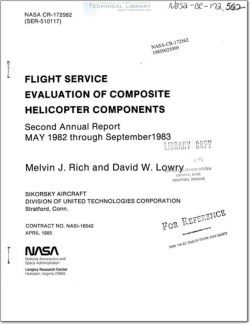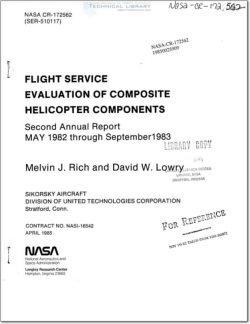NASA-CR-172-562

- Version
- 179 Downloads
- 4.68 MB File Size
- 1 File Count
- August 16, 2016 Create Date
- August 16, 2016 Last Updated
Flight Service Evaluation of Composite Helicopter Components

SUMMARY
This second annual report presents the environmental effects data
for up to four years service operation of 5-76 tail rotor spars
and three years for field exposed composite panels.
Four 5-76 tail rotor spars were returned after three and four
years of commercial operation in the Louisiana Gulf Coast region.
Full scale fatigue tests were conducted on three and four year
service spars. Two three year service spars were cut. up for
coupon testing. The full scale fatigue strengths of the three and
four year spars were of equal strength and close to the baseline
spar fatigue data.
Panels exposed for three years were returned for moisture measure-
ments and strength tests. Environmental analyses were made of the
returned tail rotor spars and composite panels. Both moisture and
strength predictions were compared with measured data. The
moisture absorption was close to the predictions. The affect on
strength was close to laboratory conditioned strength data.
SECTION 1.0 INTRODUCTION AND BACKGROUND
The environmental effects program for' composite structures was
instituted to assess the affects of environment on selected
composite materials, The program includes evaluation of in-
service components and of field exposed panels. The in-service
components are obtained from commercial S—76 operations in the
Gulf Coast Region. The field exposed panels are obtained from
locations in West Palm Beach (WPB), Florida and Stratford (STFD),
Connecticut. The data is used to compare with laboratory test/and
analytical methods.
The objective of this eight year program is to derive procedures
for establishing in-service environmental factors for both design
and component test verification.
The tasks for this program are: (1) determine the strength of
composite structural components after in-service use, (2) compare
such results with initial certification tests, (3) evaluate the
effects of component moisture content, and (4) compare coupon test
results for real time and accelerated environmental conditioning.
The schedule for this program is shown in Table I. The components
selected for in—service evaluation are the tail rotor spar and the
horizontal stabilizer. The tail rotor spar is an all graphite/
epoxy structure (ASl/6350 Ciba—Geigy System) designed by cyclic
loads. The horizontal stabilizer is a full depth sandwich struc-
ture with crossplied Kevlar/epoxy (285/5143 Dupont, American
Cyanamid System) skins on a Nomex honeycomb core. Each stabilizer
is joined by a full depth aluminum honeycomb core spar that has
unidirectional graphite/epoxy (ASl/6350) caps and overwrapped
with Kevlar/epoxy (285/5143) fabric. The stabilizer is designed
by static loads but will also be cyclicly tested under this
program to ascertain in—service environmental effects on fatigue
strength.
This second annual report is a continuation of the efforts
reported for two year commercial operation of 8-76 spars and field
exposed panels (Reference 1). The technical background on
moisture absorption characteristics, the test data for the two
year exposures, and baseline test data are contained in Reference
1.
| File | Action |
|---|---|
| NASA-CR-172-562 Flight Service Evaluation of Composite Helicopter Components.pdf | Download |

Comment On This Post